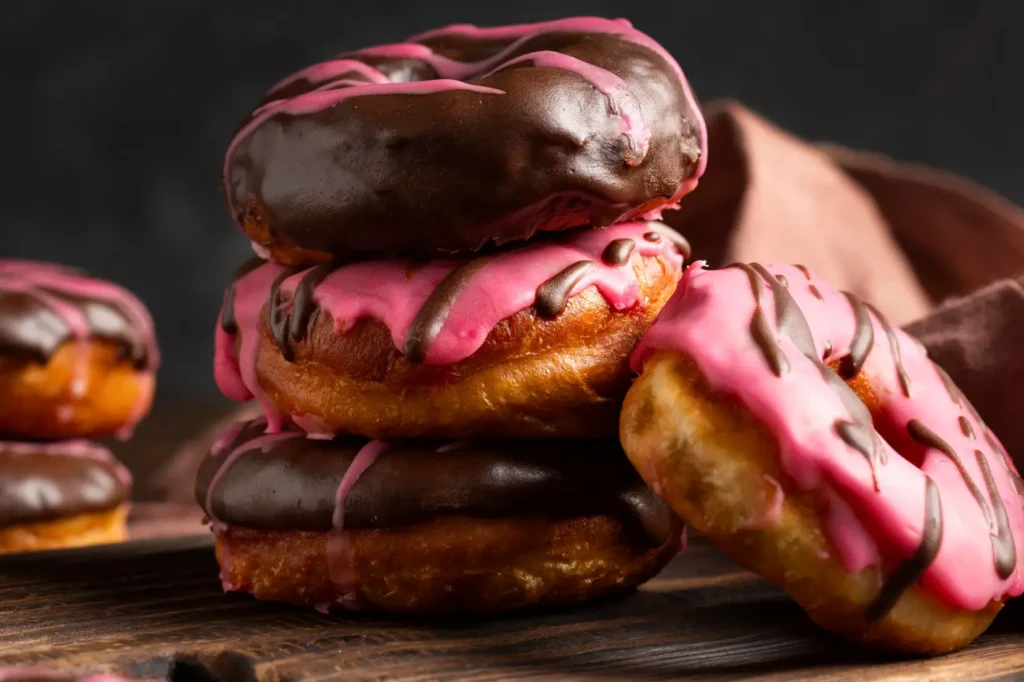Introduction
Homemade doughnuts are a beloved treat worldwide, offering a perfect balance of softness, sweetness, and a hint of crispiness. Whether you prefer them glazed, filled, or coated with sugar, making homemade doughnuts is easier than you think! In this guide, we’ll walk you through the step-by-step process of making the perfect doughnuts, from mixing the dough to frying and adding delicious toppings. Follow along and get ready to enjoy fresh, homemade doughnuts that taste even better than store-bought ones!
The Essential Ingredients for Homemade Doughnuts
Doughnuts taste best when made with the right ingredients. Each ingredient plays a key role in texture, flavor, and overall quality. Let’s break down the essentials to help you make the perfect homemade doughnuts.
Choosing the Right Flour: All-Purpose vs. Bread Flour
Flour is the foundation of your doughnuts. All-purpose flour works well for soft and fluffy doughnuts. Bread flour, on the other hand, has more protein, which creates a chewier texture. If you want classic, light doughnuts, go with all-purpose flour. For a slightly denser bite, try bread flour.
The Role of Yeast and How to Activate It
Yeast makes doughnuts rise and gives them a soft, airy texture. Use either an active dry yeast or an instant yeast for the best results. To activate the yeast, mix it with warm water or milk and a little sugar. If it foams after a few minutes, it’s ready to use. If not, the yeast might be old or the water temperature too hot or cold.
The Best Sugars to Use for Homemade Doughnuts
Sugar adds sweetness and helps doughnuts get a golden crust. Granulated sugar is the most common choice. Powdered sugar works well for glazes and coatings. For extra depth, try brown sugar, which adds a light caramel flavor.
Key Liquids: Milk, Eggs, and Butter for the Perfect Texture
Milk makes the dough rich and tender. Eggs add structure and help the dough rise properly. Butter brings flavor and softness. Use whole milk for the best texture, and always use unsalted butter so you can control the salt level.
Flavor Enhancers: Vanilla, Nutmeg, and Salt
A little extra flavor makes doughnuts irresistible. The vanilla extract gives a sweet, warm aroma. Nutmeg adds a classic bakery-style taste. Salt balances the sweetness and makes other flavors shine. Don’t skip these simple but powerful ingredients!
By using these key ingredients correctly, you’ll make delicious, homemade doughnuts every time. Ready to move on? Let’s prepare the dough!
Step-by-Step Guide to Making Doughnut Dough

Making the perfect doughnut dough requires the right technique. Follow these simple steps to get soft, fluffy, and delicious doughnuts every time.
Mixing and Kneading: Getting the Right Dough Consistency
Start by mixing flour, sugar, yeast, and salt in a bowl. Add warm milk, eggs, and melted butter. Stir until the dough comes together. Knead the dough for 8–10 minutes until it feels smooth and stretchy. f the dough feels too sticky, sprinkle in some flour. If it seems too dry, mix in a little milk. Achieving the right texture ensures soft and fluffy doughnuts.
The First Rise: How Long to Let the Dough Rest
Oil a bowl and put the dough in it, then cover it with a towel, and let it rest in a warm spot for 1 to 2 hours until it rises. It should double in size. If it doesn’t rise well, check if the yeast was activated properly. A good first rise makes doughnuts soft and fluffy.
Rolling and Cutting the Doughnut Shapes
After the dough has risen, spread it out on a surface dusted with flour. Keep it about ½ inch thick. Use a doughnut cutter or a round glass to cut the shapes. If you don’t have a cutter, use a small cup for the hole in the center. Place the cut doughnuts on a tray lined with parchment paper.
The Second Proof: Why It’s Important for a Fluffy Texture
Let the shaped doughnuts rest for 30 to 45 minutes before frying. This second rise helps them puff up and become lighter. Don’t skip this step! If the doughnuts go straight into the oil, they will turn out dense instead of soft.
Common Mistakes to Avoid While Preparing the Dough
- Using cold ingredients (they slow down yeast activity).
- Skipping the second rise (it affects texture).
- Over-kneading (can make doughnuts tough).
- Adding too much flour (leads to dry doughnuts).
Follow these steps, and your dough will be perfectly soft and ready for frying. Next, let’s fry them to golden perfection!
Frying Doughnuts to Perfection
Frying is the most important step in making light, crispy, and golden doughnuts. Follow these simple tips to get perfect results every time.
Choosing the Best Oil for Frying (Vegetable, Canola, or Peanut Oil)
The right oil affects both flavor and texture. Vegetable oil is the most common choice because it has a neutral taste. Canola oil is another great option since it has a high smoke point and is heart-healthy. Peanut oil works well too, but it has a slightly nutty taste. Avoid olive oil or butter since they burn easily.
The Ideal Temperature for Frying Doughnuts
Keep the oil temperature at 350–375°F (175–190°C). If it’s too hot, the doughnuts will brown too fast and stay raw inside. If it’s too low, they will absorb too much oil and become greasy. Use a kitchen thermometer to maintain the right heat. If you don’t have one, drop a small piece of dough in the oil. If it starts sizzling and rises to the top, the oil is hot enough.
How to Achieve an Even Golden Brown Color
Fry a few doughnuts at a time. Overcrowding lowers the oil temperature. Flip them halfway through frying to cook both sides evenly. Each doughnut should take about 1 to 2 minutes per side. Stir the oil gently to keep the heat even.
Draining Excess Oil: Paper Towels vs. Wire Racks
Once fried, place doughnuts on a wire rack to drain excess oil. This keeps them crispy. Paper towels absorb oil but can make the bottoms soggy. If using paper towels, don’t stack the doughnuts on top of each other.
Signs That Your Doughnuts Are Cooked Perfectly
A perfectly cooked doughnut feels light, fluffy, and slightly crisp. The inside should be soft and fully cooked, not doughy. The outside should have an even golden brown color. If it looks greasy or dense, the oil was too cold, or the dough wasn’t proofed enough.
Follow these frying tips, and your homemade doughnuts will turn out crispy, golden, and absolutely delicious!
Delicious Doughnut Glazes and Toppings

The right glaze or topping makes doughnuts even more irresistible. Whether you love a classic glaze, rich chocolate, or fun toppings, there’s something for everyone. Try these easy and delicious ideas.
Classic Sugar Glaze Recipe
A simple sugar glaze adds the perfect shine and sweetness. Mix together 1 cup of powdered sugar, 2 tablespoons of milk, and ½ teaspoon of vanilla extract until well combined. Whisk until smooth. Dip warm doughnuts into the glaze, then let them set for a few minutes. For a thicker glaze, add more sugar. For a thinner one, add a little more milk.
How to Make a Rich Chocolate Glaze
Chocolate lovers will enjoy this creamy topping. Melt ½ cup of chocolate chips with 2 tablespoons of butter. Stir in ¼ cup of powdered sugar and 2 tablespoons of milk until smooth. Dip the doughnuts in the glaze or drizzle it on top. Let it cool slightly so it sets nicely.
Powdered Sugar and Cinnamon Sugar Coatings
For a light and classic touch, coat doughnuts in powdered sugar. Simply roll warm doughnuts in a bowl of powdered sugar until fully covered. For a cinnamon sugar coating, mix ½ cup of granulated sugar with 1 teaspoon of cinnamon. Roll the doughnuts in the mixture while still warm for the best flavor.
Fun Toppings: Sprinkles, Nuts, and Coconut Shavings
Toppings add crunch and fun colors. Dip glazed doughnuts in rainbow sprinkles, chopped nuts, or toasted coconut shavings. Press them lightly so they stick. Try crushed cookies or mini chocolate chips for more variety.
Filling Options: Jam, Custard, and Cream
Filled doughnuts bring a delicious surprise inside. Use a piping bag to fill them with strawberry jam, vanilla custard, or whipped cream. Make a small hole in the side and gently squeeze the filling inside. Sprinkle some powdered sugar on top of it for a perfect finish.
These glazes and toppings make homemade doughnuts even more special. Try different combinations and find your favorite!
Pro Tips for Storing and Serving Doughnuts

Fresh dif you follow the right storage and serving techniques, then you can keep them soft, warm, and delicious for longer . Here’s how to do it.
How to Keep Doughnuts Fresh for Longer
Doughnuts dry out quickly if left uncovered. Keep them in a sealed container at room temperature for up to two days. If you need to keep them longer, place them in the fridge, but note that refrigeration can make them slightly firmer. Add a slice of bread to the container to help keep them extra soft.
The Best Way to Reheat Leftover Doughnuts
Reheating brings back the fresh, warm texture. Use a microwave for 10–15 seconds for a soft and warm doughnut. For a crispier finish, heat them in an oven at 350°F (175°C) for about 5 minutes. Avoid overheating, as it can dry them out.
Can You Freeze Homemade Doughnuts?
Yes! Freezing doughnuts helps them last longer. Let them cool completely before placing them in a zip-top freezer bag. Freeze for up to three months. When ready to eat, thaw at room temperature and warm them in the microwave for a few seconds. Avoid freezing doughnuts with cream fillings, as they can become watery.
Pairing Doughnuts with Coffee, Tea, or Milk
Doughnuts taste even better with a good drink. Coffee pairs perfectly with glazed and chocolate doughnuts. Tea works well with lighter options like cinnamon sugar. Milk is a classic choice that goes with any doughnut. Try hot chocolate for an extra sweet treat.
Creative Ways to Serve Doughnuts for Special Occasions
Make doughnuts the star of your event. Serve them on a doughnut wall for parties. Create a doughnut tower for birthdays instead of a cake. Use mini doughnuts as fun toppings for milkshakes. Try stacking them with whipped cream and fruit for a unique dessert.
Follow these tips to store, reheat, and serve your doughnuts the right way. Enjoy fresh, delicious doughnuts anytime!

Homemade Doughnuts Recipe
Ingredients
Method
- Activate the Yeast: Combine warm milk and sugar in a small bowl. Sprinkle the yeast over the top and let it rest for 5–10 minutes until it becomes frothy.
- Make the Dough: In a large bowl, combine flour and salt. Add the activated yeast mixture, melted butter, egg, and vanilla extract. Mix until a soft dough forms.
- Knead the Dough: Transfer the dough to a floured surface. Work the dough for 8–10 minutes until it is smooth and stretchy.
- Let the Dough Rise: Place the dough in a lightly greased bowl, cover with a damp towel, and let it rise in a warm spot for 1–2 hours or until it doubles in size.
- Shape the Doughnuts: Flatten the dough on a floured surface to approximately ½-inch thick. Use a doughnut cutter or two round cutters (one for the outer circle and one for the hole) to shape the dough.
- Second Rise: Place the shaped doughnuts on parchment paper. Cover them with a towel and let them rise for 30–45 minutes until puffed.
- Fry the Doughnuts: Warm vegetable oil in a deep pot until it reaches 350°F. Fry 2–3 doughnuts at a time for about 1–2 minutes per side, until golden brown. Remove and drain on a wire rack.
Frequently Asked Questions (FAQs)
Making homemade doughnuts can bring up a few questions. Here are some common concerns and simple solutions to help you get the best results.
Can I Bake Doughnuts Instead of Frying Them?
Yes! If you want a healthier doughnut option, baking is a great choice. Use a doughnut pan and bake at 350°F (175°C) for 12–15 minutes. Baked doughnuts won’t be as crispy as fried ones, but they will still be soft and delicious.
Why Are My Perfect Doughnuts Too Dense?
Doughnuts should be light and fluffy. If they turn out dense, the dough may not have risen long enough. Let the dough proof in a warm place until it doubles in size. Also, avoid adding too much flour, as it can make the dough tough and dry.
What Is the Best Oil for Frying Doughnuts?
Choose oils that have a mild taste and a high smoke point. Vegetable oil, canola oil, and peanut oil work best. Avoid olive oil or butter, as they burn quickly and change the taste of the doughnuts.
Can I Make the Dough Ahead of Time?
Yes! You can prepare the dough in advance. Store it in the refrigerator overnight and fry fresh the next day. Let the cold dough rest at room temperature for 30 minutes before rolling and cutting. This helps it rise properly and keeps the texture soft.
How Do I Prevent the Glaze from Melting Off?
Glaze sticks best when doughnuts are slightly warm but not hot. Let the doughnuts cool for 5–10 minutes before dipping them in the glaze. If the doughnuts are too hot, the glaze will slide off instead of setting properly.
Use these tips to make perfect doughnuts every time. Happy baking and frying!
Conclusion
Making homemade doughnuts is a fun and rewarding experience that allows you to customize flavors, textures, and toppings to your liking. With the right ingredients, proper techniques, and a little patience, you’ll be able to create doughnuts that are fluffy on the inside and perfectly crispy on the outside. Try this simple recipe and enjoy fresh, warm doughnuts straight from your kitchen. Don’t forget to experiment with different glazes and toppings to make each batch unique!
Try also our:


2 thoughts on “How to Make the Perfect Doughnuts: A Simple and Delicious Recipe”